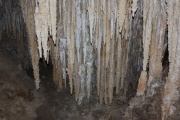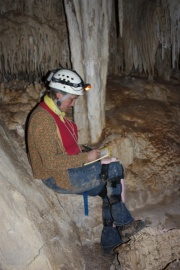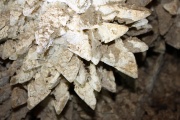Emerald survey
From LagWiki
| Emerald survey | |
|---|---|
| Location | High Guads |
| Author | William Tucker |
| Date | May 12, 2012 |
Emerald cave is a small but interesting cave especially from a cave inventory point of view. For a few months, HGRP was given the opportunity to survey this cave as part of its regular activities in the High Guads. On May 12, 2012, we concluded the Emerald survey with one final trip.
Personnel
The team for this trip included: Tammy Tucker; Phil Thommes; Mark Bulman; and me, William Tucker. We left camp at 9:30 AM and returned to camp at 7:00 PM. Everyone did an excellent job and we worked well together. The goal was to survey the right (east) side of the back passage. This side is very rugged; inaccessible except in a few places; and filled with large breakdown boulders and complex passages underneath them. Phil did an excellent job of leading the survey through this breakdown and allowing me to get a good impression of the right side of this passage. Mark followed doing foresights. Tammy performed inventory and I was kept very busy sketching this complex section of cave.
The hike
The difficulty of the hike should not be underestimated. I have now performed this hike many times in various seasons and conditions and it is to be performed with care, caution and patience and in daylight. On this trip, Phil noticed a beautiful horned lizard and I took the opportunity to photograph it. I also saw two large scat deposits. These were very full of hair so are from some type of carnivore. I would say a cat of some kind, but they were quite large; so, if it was a cat, it was a big cat. One of the scats may have had some berries of some kind associated with it so it could be a bear or something else that I cannot imagine. In any case, it was a large mammal that made these deposits.
The cave
Emerald is a small but interesting cave. It is obviously in the backreef judging from pisolitic limestone, dirty bedrock, corrosion residues, and sand and silt pods. The cave has numerous examples of good boxwork. Large crinkle blisters are also found here and good examples of corrosion residues of various colors, mostly yellow. Interesting speleothems such as flowstone, stalactites, stalagmites and helictites are also present. But, one of the most dominant features is a large amount of dogtooth spar. Spar is everywhere throughout the cave and especially under the large breakdown boulders. The only place that does not possess large amounts of dogtooth spar is the ceiling over the breakdown boulders. This is probably because the spar formed phreatically and the breakdown probably fell when the water table dropped and the buoyancy of the water was lost. So, the spar ended up under the breakdown boulders and not on the ceiling.
Another interesting fact for which I have little explanation is that most of the formations appear to have been redissolved. A lot of the spar crystals are deformed like they were later partially dissolved. Some of the stalactites show similar deformities. Another piece in this puzzle is many of the formations show a distinct layering. The older interior is harder, browner, almost marbled, calcite and the outer is less firmly adhered (almost crusty) and much whiter. In places, the outer calcite layers have slid off of the stalactites revealing the inner, darker calcite underneath. In one such location, the outer layer actually embedded itself into the corresponding stalagmite below and remains propped in the drip pit at an awkward angle. In some cases, the outer layers of stalagmites has also separated from its formation and lies on the floor like a multi-layered egg shell.
Other interesting finds in this cave include significant guano deposits; but, we only saw a few (usually 1 or 2) bats on each trip. The guano might indicate a summer freetail colony; but, we did not visit the cave at the peak of that season so were unable to observe it. A swarming site is another possibility. The few bats we did see which were flying were slow flyers and almost able to hover. Along with the guano, all three genera of beetle on the inventory form were found in the cave. Also, though we did not observe any swallows themselves, there are several mud nests on the walls. One is striped in an interesting pattern of alternating mud and guano and reminds me of a barber pole. On one occasion, a collared lizard was found in the cave.
Emerald is a very interesting cave and I was very privileged to have been given the opportunity to survey it. Thanks to the High Guads Restoration Project and the United States Forest Service.










